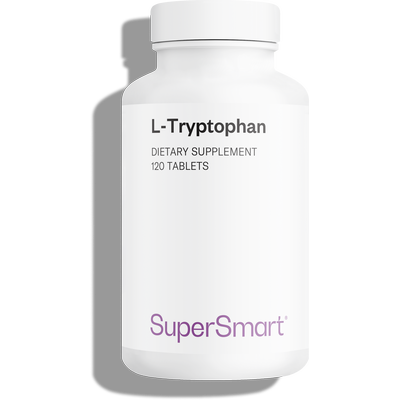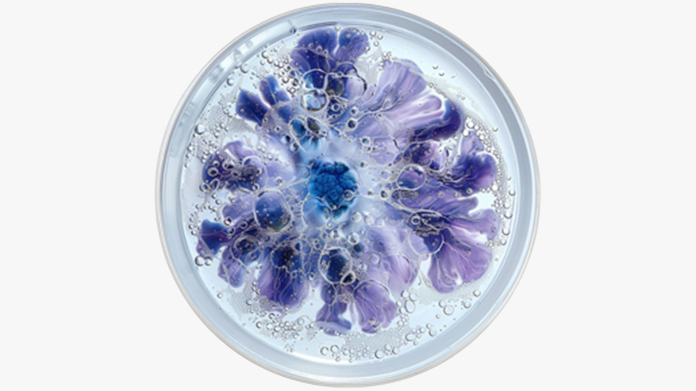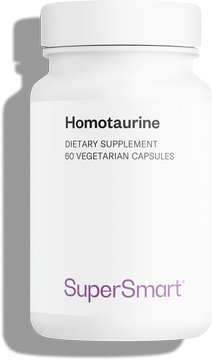Griffonia: how long does it take to take effect?
The meteoric rise in cases of depression and mood disorders around the world has propelled Griffonia to centre stage. But how long do we have to wait to see its benefits for mental health?

What is the Griffonia simplicifolia plant, and what are its benefits?
A historic natural remedy for the nervous system
Griffonia simplicifolia is a climbing plant native to West Africa, widely used in traditional medicine for its supposed effects on the central nervous system and mood regulation (1-2).
It is mainly the seeds that are consumed, prepared in various forms including decoctions, infusions, and now, frequently, as food supplements (such as 5-HTP) (3-4).
The benefits of 5-HTP on mood
Griffonia seeds contain a special amino acid, 5-hydroxytryptophan (5-HTP).
This compound, also created naturally by the human body, is a precursor of serotonin, the neurotransmitter associated with emotional balance and involved in regulating mood and stress. Serotonin is also commonly referred to as the 'happy hormone'.
Research has shown that when serotonin levels in the body are too low, several regions of the brain become less regulated, which can trigger impulsive or even aggressive behaviour, low mood or sadness.
In other words, taking griffonia increases the presence of 5-HTP (the direct precursor of serotonin) in the body, helping to support emotional balance and well-being.
5-HTP could also have a positive effect on levels of brain-derived neurotrophic factor (BDNF), a protein involved in the survival of neurons. The levels of this protein are generally reduced in cases of depression.
How long does it take to see the first effects of griffonia?
Time needed to observe the increase in serotonin
Several studies have shown that the administration of 5-HTP, whether or not via a supplement of griffonia, rapidly produces objectively measurable effects: serotonin concentration in the blood and brain increases, with a maximum peak one hour later (5).
In fact, after ingestion, 5-HTP is rapidly converted into serotonin in the gastric mucosa, kidneys, liver or small intestine.
Crucially, a small proportion of 5-HTP also crosses the blood-brain barrier (BBB) into the brain (6-7), where it is in turn converted into serotonin.
It is this ability to cross the brain's borders that makes the 5-HTP molecule so interesting, as the serotonin produced in other areas of the body cannot cross the BBB and therefore cannot reach the brain to directly influence its functions.
Because of its rapid effects, it is generally recommended to take griffonia supplements after 5pm to avoid feeling drowsy during the day.
How long does it take to feel the effects of griffonia on mood?
Be aware, however, that the almost immediate effects on circulating serotonin levels do not significantly relieve symptoms associated with mood disorders. For that, you need to wait several weeks.
The results of scientific studies into the efficacy of 5-HTP have been evaluated after 2 to 3 weeks of daily intake (8-9): this is probably the time needed to influence brain neurochemistry.
The intensity of the effects: the concentration of 5-HTP can change everything
Since the most active molecule in griffonia is 5-HTP, we need to pay close attention to its actual concentration and quantity in natural supplements.
Some of them are said to be 'normalised' or 'standardised' in 5-HTP: this means that the 5-HTP content is guaranteed by the manufacturer.
This standardisation, expressed as a percentage of active molecules, is essential for estimating the quality of the product and therefore maximising its effects.
Some supplements boast an excellent 98% 5-HTP content (e.g. SuperSmart's 5-HTP supplement, extracted from Griffonia simplicifolia).
Finally, taking the capsules every day should guarantee an intake of between 50 and 100 mg of 5-HTP, in line with the quantities assessed in research studies.
Taking Griffonia: a few precautions to make the most of its benefits
Given the many possible dangers and interactions with 5-HTP (St John's Wort, natural antidepressants, certain analgesics, etc.), it is recommended that you take this supplement under the supervision of a health professional.
It is totally contraindicated for pregnant and breastfeeding women, and for people suffering from scleroderma or Down's syndrome.
An alternative source of 5-HTP: tryptophan
The body is also capable of manufacturing 5-HTP from the amino acid tryptophan.
We therefore recommend eating enough tryptophan (found in nuts, brown rice, animal products, chocolate, etc.) to encourage optimal natural synthesis of 5-HTP in the brain.
So it's no coincidence that tryptophan supplements (such as L-Tryptophan) are also often recommended for people with mood disorders.
SUPERSMART ADVICE
References
- Carnevale G., Di Viesti V., Zavatti M., Zanoli P. Anxiolytic-like effect of Griffonia simplicifolia Baill. seed extract in rats. Phytomedicine. 2011;18:848–851.
- Carnevale G., Di Viesti V., Zavatti M., Benelli A., Zanoli P. Griffonia simplicifolia negatively affects sexual behavior in female rats. Phytomedicine. 2010;17:987–991. doi: 10.1016/j.phymed.2010.02.010.
- Irvine F.R. Woody plants of Ghana. Oxford University Press; Oxford, UK: 1961. Woody plants of Ghana.
- Xin-Zhi W., Fei-Hua W.U., Wei Q.U., Liang J.-Y. A new β-carboline alkaloid from the seeds of Griffonia simplicifolia. Chin. J. Nat. Med. 2013;11:401–405
- Maffei ME. 5-Hydroxytryptophan (5-HTP): Natural Occurrence, Analysis, Biosynthesis, Biotechnology, Physiology and Toxicology. Int J Mol Sci. 2020 Dec 26;22(1):181. doi: 10.3390/ijms22010181. PMID: 33375373; PMCID: PMC7796270.
- Abbott N. Inflammatory mediators and modulation of blood-brain barrier permeability. Cell Mol. Neurobiol. 2000;20:131–147. doi: 10.1023/A:1007074420772
- Nakatani Y., Sato-Suzuki I., Tsujino N., Nakasato A., Seki Y., Fumoto M., Arita H. Augmented brain 5-HT crosses the blood-brain barrier through the 5-HT transporter in rat. Eur. J. Neurosci. 2008;27:2466–2472. doi: 10.1111/j.1460-9568.2008.06201.x.
- Praag HM, Korf J. 5‐Hydroxytryptophan as antidepressant: The predictive value of the probenecid test. Psychopharmacology Bulletin 1972;8(4):34‐5.
- P. Goetz, Traiter la dépression en 2018, Phytothérapie (2018) 16:38-44, DOI 10.3166/phyto-2018-0003
Keywords
2 Days
The products I use are excel·lent
The products I use are excel·lent
ROSAS Josep Maria
10 Days
Delivery is prompt and I never saw a…
Delivery is prompt and I never saw a quality problem with the manufacturing. It is not possible to assess efficacy on a personal basis, since too many factors come into play. Efficacy can only be assessed statistically with a sufficient number of cases.
Roger De Backer
11 Days
I collaborates with the Supersmart…
I collaborates with the Supersmart more than 10 years. Every thing is going good. Quality of the things is good. Delivery comes in time. Five stars definitely !!!
Oleksiy
11 Days
All good
Simple, frictionless site, easy ordering, good delivery updates and execution.
Chris Robbins
13 Days
I feel better
I feel better
Peter Ammann
13 Days
Prompt delivery
Prompt delivery
JAKUB Radisch
15 Days
My new go-to for top quality supplements!
I am buying more and more of my supplements from this superb, high quality company. Cannot recommend it enough. Plus, excellent customer service with a quick, helpful team and speedy deliveries. Highly recommend Supersmart!
Cecilie H.
18 Days
SUPERSMART WHAT ELSE👍
SUPERSMART WHAT ELSE👍
DIEDERLE Christophe
21 Days
Excellent quality products with…
Excellent quality products with innovative formulas, as someone who has been suffering with acid reflux, these supplements have been lifesavers.
Oriana Moniz
21 Days
high quality supplement!
high quality supplement!
GALANT
22 Days
Good service prompt delivery
Good service prompt delivery
Mrs Marcella Reeves
27 Days
I like your clear explanation
I like your clear explanation. And how to make a choice of products for a specific health problem
Ingrid
33 Days
Great product and it arrives quickly.
Great product and it arrives quickly.
SOMMARIVA Gianni
34 Days
Excellent products and fast service.
Excellent products and fast service. What do we need more?
Margarida
38 Days
The variety of products is amazing
The variety of products is amazing, the offers are good and the sending is very fast. I just miss having a bit more of guidance about combinations, possible interactions, etc.
Maria Angeles Verdu







